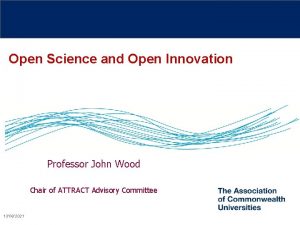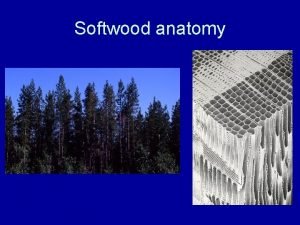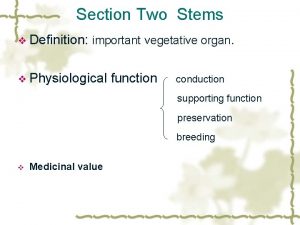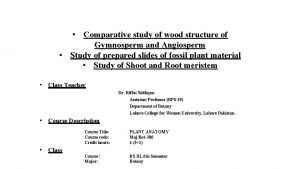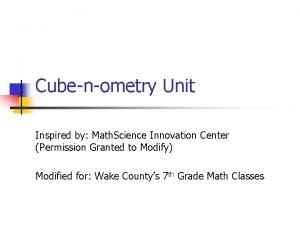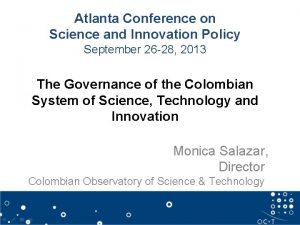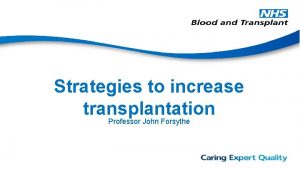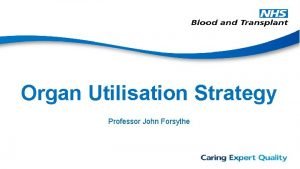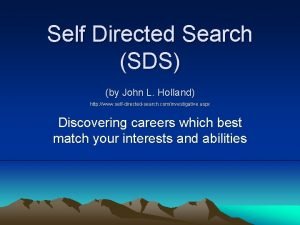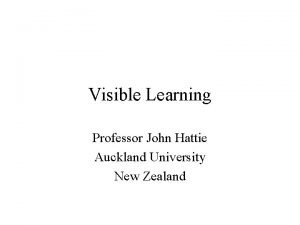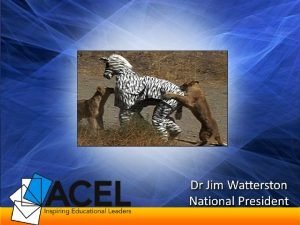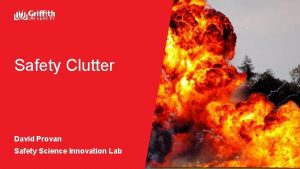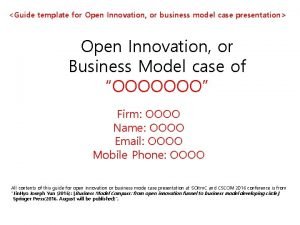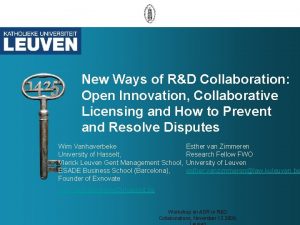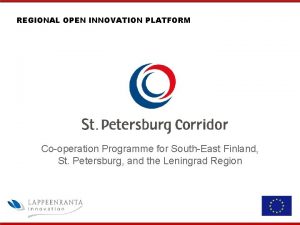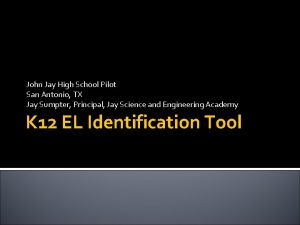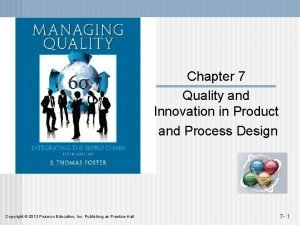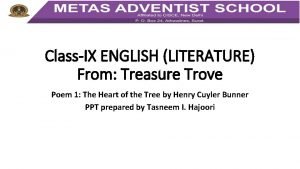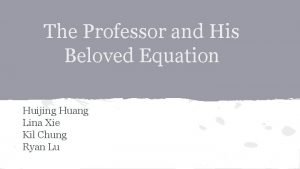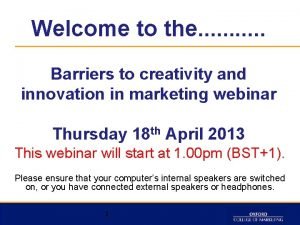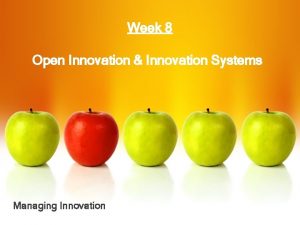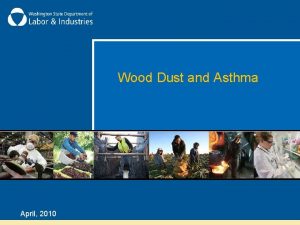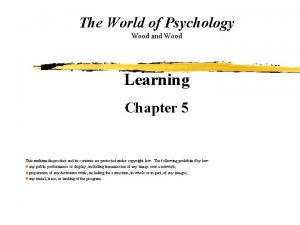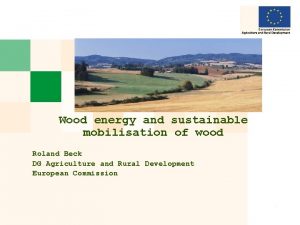Open Science and Open Innovation Professor John Wood





































- Slides: 37

Open Science and Open Innovation Professor John Wood Chair of ATTRACT Advisory Committee 13/06/2021


OSPP-REC: Open Science Policy Platform Recommendations Date of Adoption: 22 nd April 2018 1. Introduction Open Science is scholarly research that is collaborative, transparen and reproducible and whose outputs are publicly available. The European Union will not remain competitive at the global level unless it promotes Open Science, and relatedly, Open Innovation. The time to act is now.

• At its core, Open Science aims at: “increasing research quality, boosting collaboration, speeding up the research process, making the assessment of research more transparent, promoting public access to scientific results, as well as introducing more people to academic research”. By taking advantage of Open Science, researchers can enhance the quality of curiosity-driven research, maximise the value and potential impact of their work to create new avenues of knowledge, and drive scientific progress and Open Innovation within Europe and beyond. Open Science also makes research more transparent and accessible to citizens, and helps involve citizens more actively in research activities. Open Science thus “provides policymakers, research institutions, funding bodies and researchers themselves with an opportunity to critically consider: what does and should count as high-quality research; what goals researchers should pursue; how research results should be evaluated and disseminated; and how research should be supported and embedded within society”.

What is Open Science?

OSPP current areas of work • • • Prioritised recommendations for the eight ambitions of Open Science Below are a set of actionable recommendations from the OSPP to be taken as the next step towards the longer-term vision articulated by Open Science consultations and expert groups set up by the EC and other organisations in Europe and worldwide. The recommendations have been split up into the eight priorities identified from the 5 areas of the European Open Science Agenda, namely: Rewards and Incentives Research Indicators and Next-Generation Metrics Future of Scholarly Communication European Open Science Cloud FAIR Data Research Integrity Skills and Education Citizen Science

From the 2014 Yearbook Open Innovation 2. 0 • Open Innovation 2. 0 (OI 2) is a new paradigm based on a Quadruple Helix Model where government, industry, academia and civil participants work together to cocreate the future and drive structural changes far beyond the scope of what any one organization or person could do alone. This model encompasses also user-oriented innovation models to take full advantage of ideas' cross-fertilisation leading to experimentation and prototyping in real world setting.

All change but back to the past Open Science/Science 2. 0 Ø A systemic change in the modus operandi of science and research Ø Affecting the whole research and innovation cycle and its stakeholders including the public


Speech of Oettinger “We are in the middle of a true revolution — the fourth industrial revolution. It will change our industries, it will change our economy. And it will have a profound impact on our lives. We are now in the midst of the next digital revolution which is precisely based on interconnection and communication: Any object, any machine, are now starting to be equipped with sensors in this "internet of things" - sensors able to communicate and to feed in real time into processes.

Philips’ Eindhoven Campus


• There are 5 key elements in the new Open Innovation process: • Networking; • Collaboration: involving partners, competitors, universities, and users; • Corporate Entrepreneurship: enhancing corporate venturing, startups and spin-offs; • Proactive Intellectual Property Management: creating new markets for technology; • Research and Development (R&D): achieving competitive advantages in the market.

It's real! Sci-starter. com Figshare. com Citizens’ science Dataintensive Myexperiment. org Open code Open workflows Preprint Analysis Open data Data gathering Conceptualisation Ar. Xiv Roar. eprints. org Publication Open access Datadryad. org Open annotation Runmycode. o rg An emerging ecosystem of services and standards Review Impact Story Alternative Reputation systems Openannotation. org Altmetric. com Researchgate. com Scientific blogs Academia. edu Collaborative bibliographies Mendeley. com 14

e-Science and the Fourth Paradigm Thousand years ago – Experimental Science Description of natural phenomena Last few hundred years – Theoretical Science Newton’s Laws, Maxwell’s Equations… Last few decades – Computational Science Simulation of complex phenomena Today – Data-Intensive Science Scientists overwhelmed with data sets from many different sources • • • Data captured by instruments Data generated by simulations Data generated by sensor networks e-Science is the set of tools and technologies to support data federation and collaboration • For analysis and data mining • For data visualization and exploration • For scholarly communication and dissemination (With thanks to Jim Gray)

13/06/2021

There are three main global trends emerging today that will shape world in 2030: ‘ the empowerment of individuals, which contributes to a sense of belonging to a single human community greater stress on sustainable development against a backdrop of greater resource scarcity and persistent poverty, compounded by the consequences of climate change: and the emergence of a more polycentric world characterised by a shift of power away from states and growing governance gaps as the mechanisms for inter-state relations fail to respond adequately to global public demands. ’ ESPAS Report: 2012 “Global Trends 2030”

From the ESPAS report Knowledge is no longer concentrated in the hands of a few; it can be created and shared by ordinary citizens everywhere, challenging the very legitimacy of traditional sites of knowledge and information production such as universities and the media.


West Coast Connectivity


RIDING THE WAVE HOW EUROPE CAN GAIN FROM THE RISING TIDE OF SCIENTIFIC DATA A VISION FOR 2030 >

Global collaboratories • They can engage in whole new forms of scientific inquiry and treat information at a scale we are only beginning to see. • … and help us solving today’s Grand Challenges such as climate change and energy supply.

Vision 2030 (6) The public has access and can make creative use of the huge amount of data available; it can also contribute to the data store and enrich it. All can be adequately educated and prepared to benefit from this abundance of information. q Embed data science in all training and academic qualifications. q Integrate into gaming and social networks IMPACT IF ACHIEVED q Citizens get a better awareness of and confidence in sciences, and can play an active role in evidence based decision making and can question statements made in the media.

Big issues facing Universities and Public at Large • Open Access to both publications and data “all publicly funded research must be publicly available • Who is providing the data, can it be trusted? • How do I know the provenance – has it been corrupted? • Is it accessible, what type of metadata is there? • Personal and persistent identifiers, a loss of personal freedom or a passport to participate? • IPR and legal position • Personal health data – how can this be handled? • How to teach and research in this global environment?

Citizen Science What is the Zooniverse? The Zooniverse is the world’s largest and most popular platform for people-powered research. This research is made possible by volunteers—hundreds of thousands of people around the world who come together to assist professional researchers. Our goal is to enable research that would not be possible, or practical, otherwise. Zooniverse research results in new discoveries, datasets useful to the wider research community, and many publications. At the Zooniverse, anyone can be a researcher You don’t need any specialised background, training, or expertise to participate in any Zooniverse projects. We make it easy for anyone to contribute to real academic research, on their own computer, at their own convenience.

Citizen Cyber Lab and the SDGs THE CHALLENGE In September 2015, world leaders committed to achieve 17 Global Goals for Sustainable Development (also known as Sustainable Development Goals or SDGs) during the next 15 years. The Global Goals address a range of challenges to a sustainable future on this planet, including poverty, gender inequality, disease, climate change, and social injustice. How can you help ensure that the goals will be achieved? One way is to use open data to verify progress towards the goals at a local, regional, or global level. Such tracking can be done with the help of "crowdsourcing", which accelerates the analysis of large amounts of data, such as images or documents, thanks to collective efforts on the internet. We are asking you to pitch a project that tackles Global Goals using open data. The Open Seventeen Challenge aims to transform grassroots enthusiasm on the Web into new open knowledge that can help governments, the private sector, and civil society organizations achieve the Global Goals by the year 2030. All you need to do is find a data set, define your crowdsourcing goal and pitch your idea. The Open Seventeen Challenge is a joint initiative of the research organizations Citizen Cyberlab and Gov. Lab, The ONE Campaign, and the open-source company Sci. Fabric

First round of selected projects • Safecity - crowdmapping sexual violence: analysing (tagging and digitization) data on sexual violence in public spaces in India and then visualising the collated information on a map. • Crowdmapping public projects and policies in Nigeria with @c. Map. IT to track impact and effectiveness of governance. • Track the extent of poverty: identifying, mapping and following the evolution over time of critical areas (e. g. slums) documenting the extent of poverty. • Renewable energy: mapping renewable sources of energy using satellite images. • 2030 -Watch: enabling civil-society-led SDG monitoring using official indicators and indicators maintained by civil society organisations. • Crowd 2 Map Tanzania: Crowd 2 Map is a community crowd-mapping project putting rural Tanzania on the map. • Open. Space. Map PH: using satellite images to map and study the use of land in the Philippines.



Large-scale e-Infrastructures for Biodiversity Research

Architecture Collaboration Users • Common Exploratory Environment • Collaborative Virtual Organisations Semantic annotation E-Infrastructure Analysis and processing • Integration of resources • Documented, shared workflows • Grid computation Composition Resources Data • measurements, observations & sensors • other infrastructures (e. g. ELIXIR) Statistical software Distributed computing power


LERU recommendations

“An avalanche is coming – Higher Education and the Revolution ahead” – Rizvi et al 2013 ‘…the combination of marketisation – the student consumer as king with options outside universities for talented students too – and globalisation will lead to universities being less and less contained within national systems and more both benchmarked globally and a leading part of the growth of knowledge economics – collaborating and competing. In the new world the learner will be in the driver’s seat, with a keen eye trained on value. For institutions, deciding to embrace this new world may turn out to be the only way to avoid the avalanche that is coming.

3 D printing – Make, create, innovate!! • Would you like to print out the weekly shopping in the comfort of your own home? Perhaps you're in the market for a new body part printed from your own cells? OK, you might have to wait a decade or two, but 3 D printing technology is likely to change our lives forever

Goal – move from open science to open innovation The ATTRACT story: Starting with 6 of Europe’s top public labs, joining forces to co-develop next-generation detector and imaging technologies, and bring them to market The partners: » CERN » European Molecular Biology Lab » European Southern Observatory » European Synchrotron Radiation Facility » European XFEL » Institut Laue-Langevin » Aalto University » ESADE Business School » European Industrial Research Management Association 37
 Open innovation open science open to the world
Open innovation open science open to the world Professor john wood
Professor john wood Promotion from assistant to associate professor
Promotion from assistant to associate professor Fusiform rays
Fusiform rays Aerial stem modification examples
Aerial stem modification examples Mysite socccd
Mysite socccd Incremental innovation vs disruptive innovation
Incremental innovation vs disruptive innovation Angiosperm wood vs gymnosperm wood
Angiosperm wood vs gymnosperm wood Esau wood poem
Esau wood poem Wood wood teenager
Wood wood teenager His favorite subject is
His favorite subject is Math and science innovation center
Math and science innovation center Atlanta conference on science and innovation policy
Atlanta conference on science and innovation policy Professor john forsythe
Professor john forsythe Professor john forsythe
Professor john forsythe Self directed search
Self directed search Feedback hattie effect size
Feedback hattie effect size Professor john hughes
Professor john hughes Professor john stanley
Professor john stanley Safety clutter
Safety clutter Open innovation canvas
Open innovation canvas Tsmc open innovation platform
Tsmc open innovation platform Exnovate
Exnovate Open innovation platform
Open innovation platform John jay science and engineering academy
John jay science and engineering academy Rapid change
Rapid change Wwwk-6.thinkcentral
Wwwk-6.thinkcentral Hard and soft science
Hard and soft science Quality and innovation in product and process design
Quality and innovation in product and process design Metonymy definition literature
Metonymy definition literature The professor's beloved equation full movie
The professor's beloved equation full movie Natural vs social science
Natural vs social science Branches natural science
Branches natural science Natural and physical science
Natural and physical science Applied science vs pure science
Applied science vs pure science Rule of 70 population growth
Rule of 70 population growth Windcube
Windcube Barriers to creativity
Barriers to creativity

